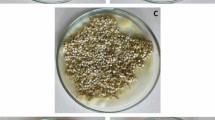Abstract
Changes in physicochemical properties, isoflavone composition, antioxidant activities, and microbial count of cheonggukjang during the manufacturing process were investigated. During fermentation, isoflavone glucosides are converted to isoflavone aglycones. After fermentation, the increased isoflavone aglycone content was determined. The total phenolic and total flavonoid content, as well as antioxidant activities, significantly increased in cheonggukjang at fermentation process. In proximate composition, fermented soybeans had the highest crude protein content. A gradual increase in the browning index and pH values was observed from the primary processing procedure to fermentation. The total bacterial count increased with each manufacturing step, except for the steamed step. The traditional processing methods for cheonggukjang from raw soybean induced several changes in chemical composition. In addition, the change of isoflavone glucosides to isoflavone aglycones during fermentation could enhance their bioavailability and antioxidant properties.

Similar content being viewed by others
References
Akande KE, Doma U, Agu HO, Adamu HM (2010) Major antinutrients found in plant protein sources: their effect on nutrition. Pak J Nutr 9(8):827–832
Akilligolu HG, Sibel K (2010) Changes in total phenols, total flavonoids and antioxidant activities of common beans and pinto beans after soaking, cooking and in vireo digestion process. Food Sci Biotechnol 19:633–639
AOAC (2005) Official methods of analysis, 18th edn. Association of Official Analytical Chemists, Washington
Bligh EG, Dyer WJ (1959) A rapid method of total lipid extraction and purification. Can J Biochem 37(8):911–917
Brand-Williams W, Cuvelier ME, Berset C (1995) Use of free radical method to evaluate antioxidant activity. LWT Food Sci Technol 28:25–30
Chang TS, Ding HY, Sorgan S-KT, Wu CY (2007) Metabolism of the soy isoflavones daidzein and genistein by fungi used in the preparation of various fermented soybean foods. Biosci Biotechnol Biochem 71:1330–1333
Chien HL, Huang HY, Chou CC (2006) Transformation of isoflavone phytoestrogens during the fermentation of soymilk with lactic acid bacteria and bifidobacteria. Food Microbiol 23:772–778
Cho KM, Lee JH, Han DY, Ahn BY, Kim H, Seo WT (2011) Changes of phytochemical constituents (isoflavones, flavonols, and phenolic acids) during Cheonggukjang soybeans fermentation using potential probiotics Bacillus subtilis CS90. J Food Compos Anal 24:402–410
Coward L, Smith M, Kirk M, Barnes S (1998) Chemical modification of isoflavones in soy foods during cooking and processing. Am J Clin Nutr 68:1486–1491
Fan JF, Zhang YY, Chang XJ, Masayoshi S, Li ZG (2009) Changes in the radical scavenging activity of bacterial-type Douchi, a traditional fermented soybean product, during the primary fermentation process. Biosci Biotechnol Biochem 73:2749–2753
Hajimahmoodi M, Hanifeh M, Oveisi MR, Sadeghi N, Jannat B (2008) Determination of total antioxidant capacity of green teas by the ferric reducing/antioxidant power assay. Iran J Environ Health 5:167–172
Hur SJ, Lee SY, Kim YC, Choi I, Kim GB (2014) Effect of fermentation on the antioxidant activity in plant-based foods. Food Chem 160:346–356
Jeon HL, Yang SJ, Son SH, Kim WS, Lee NK, Park HD (2018) Evaluation of probiotic bacillus subtilis P229 isolated from Cheonggukjang and its application in soybean fermentation. Food Sci Technol 97:94–99
Kim JY, Choi JN, Kang DJ, Son GH, Kim YS, Choi HK, Kwon DY, Lee CH (2011) Correlation between antioxidative activities and metabolite changes during Cheonggukjang fermentation. Biosci Biotechnol Biochem 75:732–739
Ko HM, Choi SJ, Lee WS, Choi UK (2014) Quality characteristics of cheonggukjang made with the smoked soybeans. Korean J Food Nutr 27(02):274–279
Kulling SE, Honig DM, Metzler M (2001) Oxidative metabolism of the soy isoflavones daidzein and genistein in humans in vitro and in vivo. J Agric Food Chem 49(6):3024–3033
Lee BR, Muneer S, Jung WJ, Avice JC, Ourry A, Kim TH (2012) Mycorrhizal colonization alleviates drought-induced oxidative damage and lignification in the leaves of drought-stressed perennial ryegrass (Lolium perenne). Physiol Plant 145(470):440–449
Ludorff W, Meyer V (1973) Fische und fischerzeugnisse, vol. 6. Paul parey
Mariusz KP, Jun U, Yukihiko L (1999) Daidzein and genistein but not their Glucoside are absorbed from the rat stomach. FEBSI Lett 447:287–291
Muratsugu M, Washino K, Onchi Y, Yamaguchi A, Kumaki A, Shimooka I, Nakanishi M (2017) Changes in biotin levels during production of natto, Japanese fermented soybean. Int J Food Allied Sci 3(1):1–9
Nicoli MC, Anese M, Parpinel M (1999) Influence of processing on the antioxidant properties of fruit and vegetables. Trends Food Sci Technol 10(3):94–100
Park NY, Seong JH, Choi MS, Moon KD, Kwon JH, Jeong YJ (2008) Comparison of functional properties of cheonggukjang by using red ginseng. J Korean Soc Food Sci Nutr 37(03):261–266
Son YJ, Kang SH, Ko JN, Lee YK, Hwang IK, Kang HJ (2017) Changes in physicochemical characteristics and nutritional values of soybean, meju, and doenjang by varying sowing periods. J Food Sci Technol 49:56–62
Torino MI, Limón RI, Martínez-Villaluenga C, Mäkinen S, Pihlanto A, Vidal-Valverde C, Frias J (2013) Antioxidant and antihypertensive properties of liquid and solid state fermented lentils. Food Chem 136(2):1030–1037
Wang LJ, Yin LJ, Li D, Zou L, Massayoushi S, Eizo T, Li LT (2007) Influences of processing and NaCl supplementation on isoflavone contents and composition during Douchi manufacturing. Food Chem 101:1247–1253
Xu BJ, Chang SKC (2008) Total phenolics, phenolic acids isoflavones, and anthocyanins and antioxidant properties of yellow and black soybeans as affected by thermal processing. J Agric Food Chem 56:7165–7175
Xu L, Du B, Xu BJ (2015) A systematic, comparative study on the beneficial health components and antioxidant activities of commercially fermented soy products marketed in China. Food Chem 174:202–213
Author information
Authors and Affiliations
Corresponding author
Ethics declarations
Conflict of interest
The authors declare no conflicts of interest.
Additional information
Publisher's Note
Springer Nature remains neutral with regard to jurisdictional claims in published maps and institutional affiliations.
Rights and permissions
About this article
Cite this article
Piao, YZ., Eun, JB. Physicochemical characteristics and isoflavones content during manufacture of short-time fermented soybean product (cheonggukjang). J Food Sci Technol 57, 2190–2197 (2020). https://doi.org/10.1007/s13197-020-04255-2
Revised:
Accepted:
Published:
Issue Date:
DOI: https://doi.org/10.1007/s13197-020-04255-2




